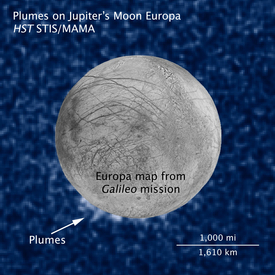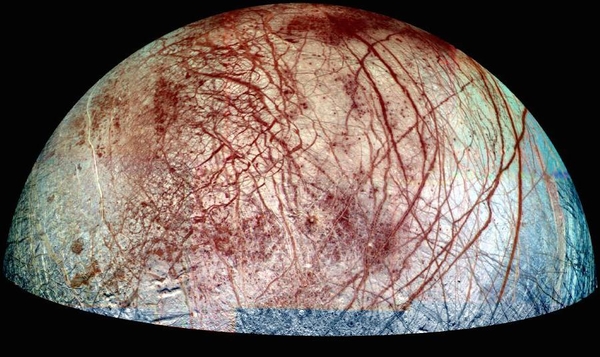JUICE's secondary target: Europa
At about the same size as Earth's moon, Europa is the smallest of the Galilean moons. Like the other Galilean satellites, it is tidally locked, always showing the same face towards Jupiter during its 3.5-day journey around the planet. Because of the moon's elliptical orbit, the gravitational pull from Jupiter varies as the moon orbits, creating tides that flex and relax Europa's surface. The resulting tidal heating provides energy to the moon's shell and, possibly, its interior layers.
A subsurface ocean
 |
| Suspected water plumes on Europa. Credit: NASA, ESA, W. Sparks (STScI), and the USGS Astrogeology Science Center |
Of all Jupiter's moons, Europa is the one scientists believe is more likely to be habitable. As was the case with Ganymede, the Galileo mission provided strong evidence for the existence of subsurface ocean lying beneath Europa's crust. This liquid layer is thought to have twice as much water as Earth's oceans, but its depth, composition and interactions with the deep interior and the icy crust remain unknown.
More recently, the Hubble Space Telescope observed what might be water-vapour plumes emerging from the moon's icy crust and rising some 160 kilometres above the surface. These geysers could provide a way for JUICE to sample the water in Europa's subsurface ocean and look for signatures of life without the need to drill into the icy crust. The plumes are equally exciting from a geological point of view as they provoke questions like: What processes give rise to these geysers? What factors control how strong and variable they are? Scientists hope to be able to answer these questions following JUICE's investigations, as well as find out more about the chemistry of the plumes.
Curious cracks
Europa's surface, one of the smoothest of any solid body in the Solar System, is another puzzle that JUICE scientists hope to solve. The moon has cracks and streaks etched onto it but very few craters, which points to the surface being relatively young and the moon tectonically active. Indeed, recently, researchers found evidence for a global plate-tectonic system at Europa using images from the Galileo mission. The observations show that some of the features on the moon's surface could be like the mid-ocean ridges on Earth, that is, regions where new surface material is formed. Other cracks could be similar to subduction faults, locations where terrain moves under a second (overriding) plate at the surface. Researchers also saw evidence for cryovolcanoes on this overriding plate, but little is known about them.
These active zones, which could provide a way to exchange material between the moon's surface and its ocean, will be a particular focus of JUICE. There is still mystery surrounding the formation of the various features on Europa's surface, both its bright, striated plains and the darker, smeared regions. JUICE will identify and investigate the geological processes responsible for the distinctive formations on the moon, as well as determine to which degree different processes can exchange material between the surface and the liquid reservoirs underneath it.
 |
| Blood-red scars and veins on Europa. Credit: NASA/JPL/University of Arizona |
Chemistry and composition
JUICE's instruments will probe the chemistry of Europa's surface at these active regions, searching for elements essential to life and substances that could provide evidence of past or present life on the moon. JUICE's detailed study of the chemistry and composition of Europa also aims to provide clues into how specific elements arrive at the surface. Which substances originate underground and are brought up by tectonics or cryovolcanism, and which particles arrive at Europa from the other moons via Jupiter's magnetosphere?
The mission will also investigate Europa's icy crust and how it interacts with the ocean underneath it. JUICE will use an ice-penetrating radar to determine if pockets of liquid water exist within the first few kilometres of the subsurface. Depending on how thick the icy crust is, the radar will also be able to probe the interface between the shell and the subsurface ocean.
JUICE will flyby this moon twice, at middle latitudes over both of Europa's hemispheres. At closest approach, the spacecraft will be at an altitude of about 400 km.
